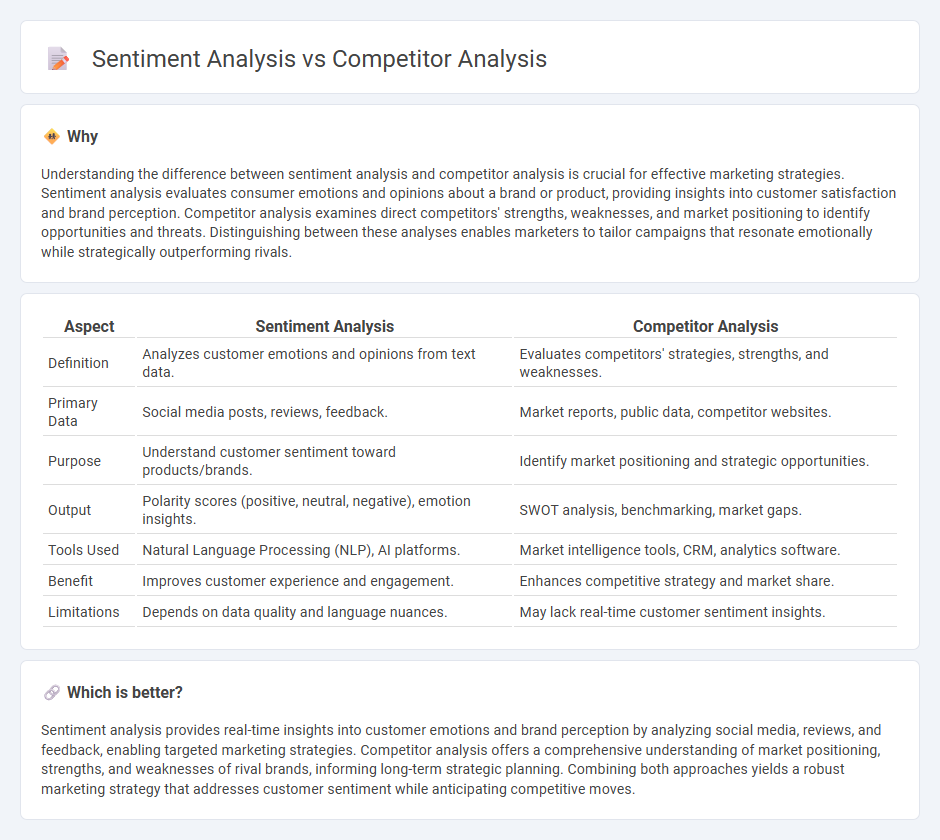
Sentiment analysis leverages natural language processing to evaluate customer opinions and emotions toward a brand, product, or service, providing insights into consumer attitudes and market trends. Competitor analysis involves systematically examining rival companies' strategies, strengths, and weaknesses to identify opportunities and threats within the industry. Discover how integrating both approaches can enhance your marketing intelligence and strategic decision-making.
Why it is important
Understanding the difference between sentiment analysis and competitor analysis is crucial for effective marketing strategies. Sentiment analysis evaluates consumer emotions and opinions about a brand or product, providing insights into customer satisfaction and brand perception. Competitor analysis examines direct competitors' strengths, weaknesses, and market positioning to identify opportunities and threats. Distinguishing between these analyses enables marketers to tailor campaigns that resonate emotionally while strategically outperforming rivals.
Comparison Table
| Aspect | Sentiment Analysis | Competitor Analysis |
|---|---|---|
| Definition | Analyzes customer emotions and opinions from text data. | Evaluates competitors' strategies, strengths, and weaknesses. |
| Primary Data | Social media posts, reviews, feedback. | Market reports, public data, competitor websites. |
| Purpose | Understand customer sentiment toward products/brands. | Identify market positioning and strategic opportunities. |
| Output | Polarity scores (positive, neutral, negative), emotion insights. | SWOT analysis, benchmarking, market gaps. |
| Tools Used | Natural Language Processing (NLP), AI platforms. | Market intelligence tools, CRM, analytics software. |
| Benefit | Improves customer experience and engagement. | Enhances competitive strategy and market share. |
| Limitations | Depends on data quality and language nuances. | May lack real-time customer sentiment insights. |
Which is better?
Sentiment analysis provides real-time insights into customer emotions and brand perception by analyzing social media, reviews, and feedback, enabling targeted marketing strategies. Competitor analysis offers a comprehensive understanding of market positioning, strengths, and weaknesses of rival brands, informing long-term strategic planning. Combining both approaches yields a robust marketing strategy that addresses customer sentiment while anticipating competitive moves.
Connection
Sentiment analysis provides valuable insights into customer opinions and emotions toward products or brands, enabling businesses to gauge market perception effectively. Competitor analysis uses this sentiment data to benchmark a company's brand sentiment against rivals, identifying strengths and weaknesses in market positioning. Together, these tools allow marketers to refine strategies by understanding both consumer attitudes and competitive dynamics in real time.
Key Terms
**Competitor Analysis:**
Competitor analysis evaluates market positioning, strengths, weaknesses, and strategies of direct competitors to inform business decisions and identify growth opportunities. It involves gathering data on product offerings, pricing, marketing tactics, and customer feedback to benchmark performance and anticipate market trends. Explore how competitor analysis can drive strategic advantages and enhance your business outcomes.
Benchmarking
Competitor analysis benchmarks a company's performance by evaluating market position, product offerings, and strategic initiatives against key rivals, providing actionable insights for growth and differentiation. Sentiment analysis measures consumer opinions and emotions from social media, reviews, and feedback to gauge brand reputation and customer satisfaction. Explore how leveraging both methods can enhance comprehensive market benchmarking strategies.
Market Share
Competitor analysis provides a comprehensive evaluation of competitors' strengths, weaknesses, and market share to identify opportunities and threats within the industry, essential for strategic decision-making. Sentiment analysis examines customer opinions and emotions expressed through social media and reviews, offering insights into brand perception and customer satisfaction but does not directly quantify market share. Explore in-depth comparisons to understand how both analyses complement each other in optimizing market strategies.
Source and External Links
How to Conduct a Competitive Analysis | BDC.ca - A competitive analysis involves identifying direct, secondary, and substitute competitors and evaluating their strengths and weaknesses relative to your business using industry benchmarks and classification systems like NAICS.
What Is a Competitive Analysis? (with Template + Examples) - Competitive analysis is researching competitors' strategies, products, and pricing to find market gaps and differentiation opportunities and better position your own offerings.
Why Competitor Analysis Matters - Backlinko - Competitor analysis includes identifying direct and indirect competitors, studying their customer segments, and using tools like Semrush Organic Research for insights on market positioning and online visibility.
 dowidth.com
dowidth.com